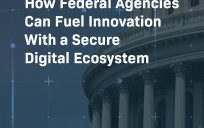This blog post is an excerpt from GovLoop’s recent guide, “Taking Government Cloud Adoption to the Next Level.”
The expression “think small” might only be inspirational to nanoengineers, but that approach is actually also a hallmark of success for agencies moving to the cloud. Why? Because when done right, cloud technologies will change the way you operate. Think about it: instead of an internet-accessed version of a traditional call center, thanks to the cloud, you might be able to text message answers.
Those possibilities means cloud disrupts your business practices. That disruption can mean success for your agency – when undertaken correctly. But if you don’t adopt cloud according to the “think small” approach and other best practices, you can get stung.
To understand government best practices for adopting cloud solutions, GovLoop sat down with Bob Ainsbury, Chief Product Officer at Granicus, the largest cloud solutions provider for government. In his work, he’s found that focusing on agency missions and outcomes, starting with small adoption projects, and building support for transformations before implementation are three crucial aspects of successful cloud migrations.
First, Ainsbury discussed that when selecting, implementing, and using cloud platforms, agencies need to understand how the cloud is advancing the agency mission. The cloud is simply a catalyst for the mission, so leaders need to focus less on the actual product and more on what an agency aims to accomplish with the cloud.
“The key strategy to make sure that cloud solutions and migrations don’t become about the product is to always tie back to the impact that you’re trying to achieve,” he explained. “This could be getting more kids into foster homes, or just fewer phone calls coming into an agency call center.” Ainsbury added that mapping the solutions to the mission ensures that frontline employees examine how to best help constituents rather than how to fill out a report.
Additionally, Ainsbury advised that training employees to use the cloud to both enable day-to-day processes and create new processes that advance the mission is crucial. By binding the cloud to the mission outcomes, employees are more motivated to adopt cloud solutions and find new ways to incorporate the cloud into everyday customer services.
When Granicus assists state and local governments in adopting cloud solutions, they have found that constituents are looking to access more information online like community meeting agendas and videos. That’s why they advise governments to use the cloud to digitize more information and provide more digital services.
Next, Ainsbury highlighted that although wholesale adoption of the cloud in an agency can be difficult, transitioning individual functions or processes to cloud solutions is not as daunting. Many times, agencies want to have one big transformation of systems, but according to Ainsbury, successful cloud migrations actually happen when agencies decide to change small, singular functions first.
That’s why he advised that agencies phase in the use of cloud technologies over time to mitigate the organizational disruption caused by new systems and business processes. “There should be an incremental model, with minimum viable adoption initially,” Ainsbury said. “A complementary adoption of cloud solutions would prevent a wholesale disruption, which is important because agencies must change and adapt not just IT-wise, but organizationally.”
Third, Ainsbury recommended that agency leaders work to develop buy-in from frontline staff members and fellow leaders for cloud migrations before formally starting the process. Focusing on the organizational mission and demonstrating the success of smaller cloud solutions can help build a constituency of enthusiasts, but he stressed that making sure employees are motivated from the start is critical to a cloud migration.
“Really what you should be doing is embracing the people who will be the influencers of the cloud migration success and deciding what it is you are trying to accomplish,” Ainsbury said. “Do that long before a decision is made on the vendor or other details.”
Incorporating enthusiastic employees into the planning and design phase of transformations can ensure that the cloud solutions are fixing common problems experienced among employees that impact the agency mission. It is not beneficial to constituents if agencies adopt the cloud but fail to use it for services and business processes.
Agencies at all levels of government need to find ways to migrate IT systems to cloud-based products, but they need to do it in an effective and efficient way. That means that during cloud transformations, agency leaders should continuously tie new solutions to core missions and services, use an incremental model to slowly phase in new processes and platforms, and build an enthusiastic constituency of employees to guide the migration process. Following these keys will help any agency adopt cloud-based solutions as they continue to seek innovative ways to serve citizens.
For more information about taking cloud to the next level, you can find the full guide here.






Leave a Reply
You must be logged in to post a comment.